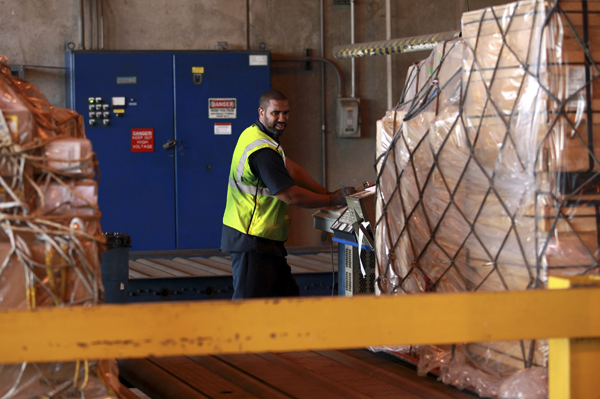
Sometimes you just have to connect the
dots.
While air cargo races to implement some
new rules put down last week by U.S. Transportation Security Administration
(TSA), the agency appears at a hearing in Washington, D.C. telling U.S.
Congress what it is doing to make air cargo safer.
Unusual snowfall blanketed Istanbul last
week as global air cargo management met at IATA’s World Cargo
Symposium March 7-10.
But while the event plowed on with a program
of pre-canned topics, many conferees were thinking and talking about
an Emergency Amendment (EA) from the TSA that came down like a thunder-clap
on Friday, March 4.
Not only did the EA direct new procedures,
the language and specificity of the EA document sent some international
air carriers and their lawyers into a frenzy, trying to figure out exactly
just what the hell TSA was demanding.
On Thursday of last week, at the same
time air cargo was prosperous on the Bosphorus, it turns out that the
TSA was in front of the U.S. Homeland Security Subcommittee on Transportation
Security up on Capitol Hill in Washington, D.C.
TSA at HSS is a fairly routine event.
U.S. Congress people who are the elected
representatives in various districts all over the USA pose questions
directly to these TSA officials that usually point at one subject:
"What have you done for us lately?"
So this time in their 2011 kickoff appearance
in front of the all-powerful U.S. Congress, TSA arrived with some new
rules in hand (EA).
It is not much of a reach to imagine that
perhaps TSA thought this would blunt the politicians’ demand of
new rules that the real world couldn’t implement without significant
negative impact on the supply chain and business.
In hearings of this type that have occurred
in the past, we have heard CPB and TSA use phrases like “We have
to not only be effective and work with industry.”
Of course, those sentiments have been
recognized by air cargo stakeholders and are appreciated.
The late Ed Kelly and his successor Doug
Brittin, General Manager Air Cargo at TSA, proved time and again that
they were concerned and connected to the interests of both air cargo
and the politicians.
We suspect TSA cooked up what can be
described as a preemptive measure to show The United States Congress
that they are really working on tightening the security screws to make
air cargo shipping safer.
But the actual document now has some people
in the air cargo industry roiling.
What the U.S. Congress thought is now
a matter of The Congressional Record.
In a case of classic establishment-speak,
the actual text – just a couple of paragraphs – of this
latest EA is a masterwork at obfuscation, not because of what it says,
but rather because of how broad, masterfully imprecise and open for
interpretation it is.Some legal eagles can pat themselves on the back
for this work of genius aimed at the politicians, but sadly it represents
a nightmare for those having to implement it.
No one questions or has an argument with
security measures; it is understood and accepted that they will be embedded
in the fabric of the industry for many years.
To put it in context, some of these security
measures make sense because we are dealing with a dead serious matter.
Yet just last week, when Senator Joe Manchin,
a member of the Senate Armed Service Committee, asked which countries
pose the biggest threat to the U.S., the National Security Director,
James Clapper [Air Force general, ret.] responded that it was Russia
and China.
That same week, John Sammon, the Assistant
Administrator for Transportation Sector Network Management told the
Congressional Subcommittee that, “Al Qaeda in the Arabian Peninsula
(APAQ) has declared war on U.S. aviation.”
So which is it?
Do these people ever talk to each other?
Most things these days are imported from
China and these rules are aimed at imports into the U.S.
While airlines, forwarders, ground handlers
and shippers jump through lots of hoops to ensure compliance, it would
be reassuring to be able to assume that the measures contemplated have
a little more to do with reality, not just Washington politics, because
every time they yank the chain, another flurry of the “multi-layered”
security regime triggers collective waves of paroxysm in an industry
that operates with extremely thin margins already.
At least John Sammon was upfront and told
the subcommittee that the Emergency Amendment has caused confusion.
That is the understatement of the century!
We have been in contact with various industry representatives and the
response is identical and discouraging.
It’s unclear whom it affects, who
has to do what and how, but otherwise its wordsmithing is absolutely
brilliant!
Here are some samples of feedback FlyingTypers
has received:
FT: What is
your reaction concerning the TSA Emergency Amendment that just came
out?
DBA Distribution Services, Inc.: The
recent TSA Announcement perhaps more than ever before underscores the
necessity for some global uniformity in security for cargo traveling
on both passenger and cargo aircraft.
Kneejerk reactions from politicians who
have very little familiarity with the cargo business are wreaking havoc
in our industry.
All of the major air carriers already
have in place security protocols that provide a good measure of safety
to passengers and crew. Admittedly, even exhaustive security safeguards
are not 100 percent foolproof, but in my view these recently announced
TSA measures add nothing to the effort to further secure the safety
of aircraft and people flying on them.
Perhaps the delegates to the just concluded
IATA World Cargo Symposium in Istanbul should have utilized that forum
to come up with a constructive plan of cooperation among all the parties
involved in global aviation and settle finally on one universally accepted
security standard.
It is long overdue.
FT: What does
it mean to you and your business?
Kuehne + Nagel: It
is difficult at this stage to ascertain the full impact, specifically
due to the nature of how the amendment has been communicated.
We do categorically support all initiatives
in the interest of security and as such work actively with all regulatory
agencies to implement and develop initiatives to secure the air transport
chain.
In cases where we have concerns, we actively
try and work with all regulatory agencies to minimize negative impacts
and ensure a focus on the intended goal.
FT: What is
your reaction to it?
K+N: Our reaction,
similar to many in the industry is one that is underscored by surprise
and concern.
Our surprise originates from the fact
that this amendment was not otherwise communicated to the forwarding
industry directly.
It is the forwarder/intermediary for
whom this amendment has a significant impact.
In fact, the amendment denotes that the
direct air carriers are responsible to communicate these changes, and
the subsequent carrier requirements to meet same, to those entities
that are tendering cargo.
That is neither efficient, nor conducive
to a homogenous understanding/interpretation of the requirements.
We have a larger concern respective to
the applicability of the regulation and its impact to pre-existing in-country
security regulations, ones that would otherwise cover the security risk
that this amendment is targeting.
Moreover, if investments have been made
based on those in-country regulations, those investments may be null
and void.
We are also concerned (and this has been
evidenced in the past) that many airline partners (to whom the regulations
directly apply) may interpret the regulations in various ways.
This could potentially result in each
airline, in each country, requiring a different set of statements or
processes from the respective forwarder/intermediary that is tendering
cargo.
For example, Carrier X requires a statement
to read in a certain way, and carrier B may require a statement to read
in another way . . . both operating at the same overseas origin, both
transiting into the U.S.
This will be virtually impossible to
manage.
FT: What kind
of information are you receiving from the carriers?
K+N: Carriers have
been communicating in a limited manner as a result of the fact that
they too are unclear on the impact.
FT: Will it
accomplish what is intended?
K+N: We cannot comment
on the efficacy, as we don't fully understand the intended target.
What we do know is that the Guideline
does not take into consideration the fact that a shipper may have a
"known" relationship with the forwarder at Origin, may be
a registered known shipper per the local in country regulations, but
may not have an active billing history with the forwarder (due to the
incoterms under which they have traditionally transacted) which to our
understanding is a requisite to make the statements required by this
amendment.
FT: How clear
are the guidelines?
K+N: Whilst they
are clear, we have concerns on their applicability and impact to existing
regulations.”
 |
One carrier, AA Cargo, issued this as the
statement to be used by its customers:
"All shipments tendered on this
Master Air Waybill were received from persons having an established
account for at least one year with a physical shipping address and a
payment, invoice, or credit history of at least one year."
Looking at the Amendment, it mandates
airlines to request account history and other as yet unspecified details
from shippers and forwarders for each air waybill shipper, with the
forwarder attesting to the accuracy of the data for the shipper.
It doesn’t specify at which point
in time this has to occur nor in which format this is to be presented,
entered, stored and transmitted.
It is fair to assume TSA needs advance
shipper information – waiting for the AMS data at wheels up no
longer satisfies the intelligence processing needs.
So far so good, but why not take the time
to work out the details with industry after it has been proven the latter
can perform under time pressure and implement new requirements effectively?
And the Amendment makes no distinction
between air cargo carried on passenger and all-cargo aircraft and express
carriers.
The specific incident last October, which
allegedly TSA and Congress aim to address, was an express shipment.
This has nothing to do with the traditional
forwarder/airline environment and the “known shipper” regime.
While trying to get our head around this
threat – and let’s stay with the Middle East for the time
being – and the loophole was the individual/retail shipper, why
apply it across the entire supply chain by adding yet another layer
which no one really knows will be effective in stopping a similar attempt?
Even accepting the premise that Al Qaeda
has declared war on U.S. aviation – and this is hardly news –
why would a group sophisticated enough to build an explosive device
undetectable by X-ray resort to the same method next time, when the
facts of life, whether we like it or not, are that there are innumerable
ways to try to blow up a plane?
It is sad to think that global air cargo
is being pummeled at times like this, just so that politicians can say,
“We have done everything in our power to prevent another attack,”
whether that is true or not.
So what we are left with is the need to
bring some constructive change once and for all.
If air cargo expects it’s voice
to be heard, then we think it is time to spread out the heavy lifting.
A major international consensus needs
to be documented as the industry gets together and transforms itself
to deliver impact that will always be considered when new rules are
suggested or demanded by government and others.
Maybe a powerful voice for air cargo will
be found in that TIACA led, newly formed consortium, GACAG.
Air Cargo needs to hit the ground running
in 2011, working with TSA and governmental agencies everywhere to lift
everyone’s prospects for success.
Perhap it is IATA with Des Vertannes as
head of cargo and a new IATA DG that will draw air cargo together.
Our bet is that some day in the future
we will recall that it was necessary to have all hands on deck to finally
end this stop-start era of ambush rules and regulations.
Ted Braun/Geoffrey |





